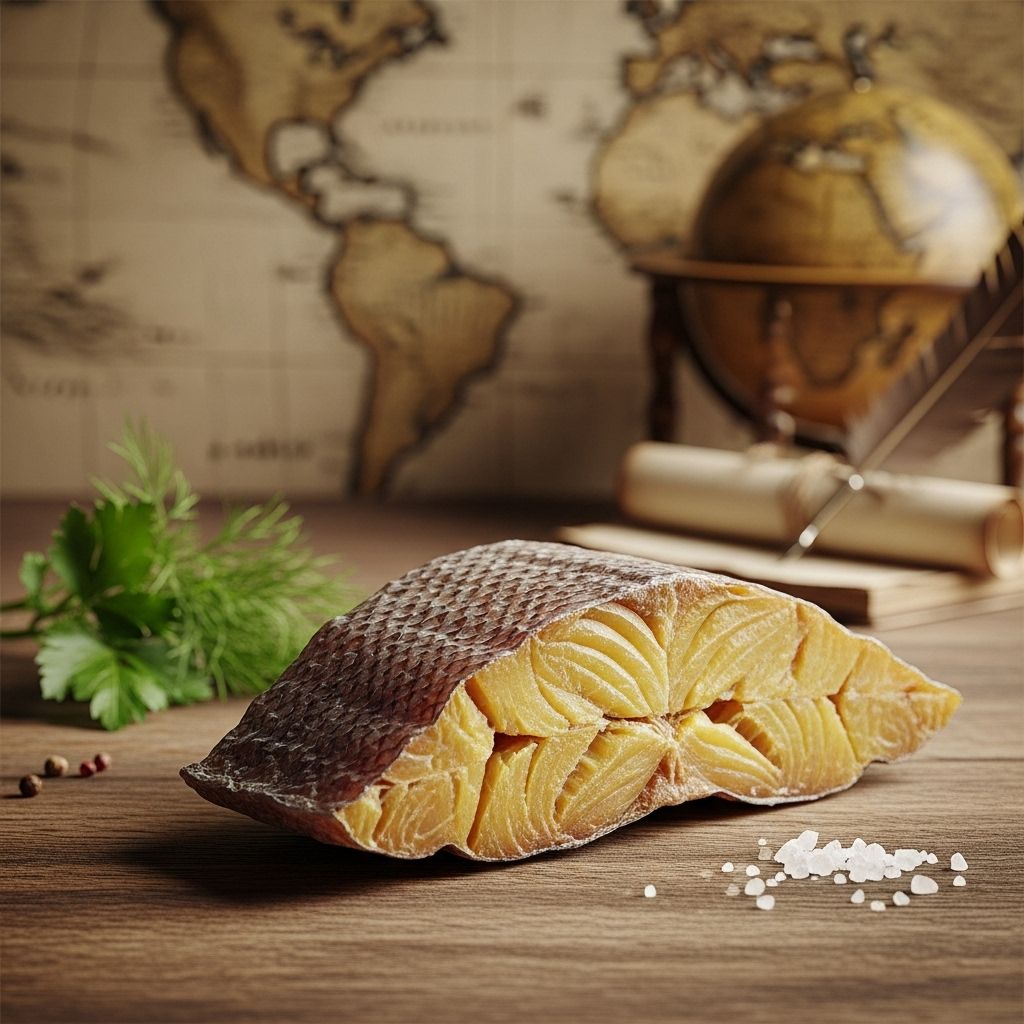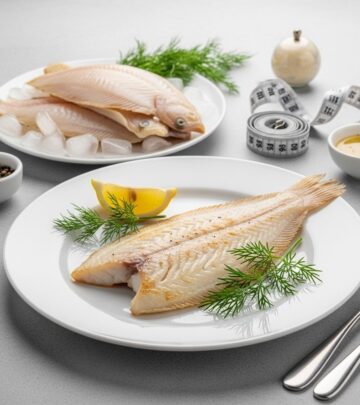What Is Stockfish? Origin, Benefits, Uses, and Taste of the Legendary Dried Cod
Ancient air-drying turns cod into a staple prized for its firm texture and deep umami.

Table of Contents
- What Is Stockfish?
- The History and Production of Stockfish
- Cultural and Culinary Significance
- Nutritional Benefits of Stockfish
- Uses Worldwide: Dishes and Preparations
- Taste and Texture Profile
- Grades, Quality & Buying Stockfish
- Fun Facts About Stockfish
- Frequently Asked Questions (FAQs)
What Is Stockfish?
Stockfish is unsalted, air-dried fish—traditionally cod—preserved using cold air and wind on wooden racks called “hjell” on Norway’s coast. Unlike salted dried fish (klippfisk), stockfish retains the natural flavor and texture of the fish by eschewing salt in its preservation method.
The process of naturally air-drying fish is one of the world’s oldest food preservation methods, dating back thousands of years. Stockfish is known for its rock-hard texture, long shelf-life, and high concentration of nutrients.
The name “stockfish” derives from the West Frisian word “stokfisk” (stick fish), referencing the wooden racks it is dried upon or the fish’s stick-like hardness after drying.
The History and Production of Stockfish
Origins
Stockfish’s roots reach back over a millennium, with archaeological and written records confirming its role as a staple food for Vikings and medieval traders. It became a vital export commodity, particularly for Norway, shaping generations of nutrition, trade, and cuisine throughout Europe and further afield.
Traditional Manufacturing Process
- The finest stockfish is made from skrei cod, which migrate annually to Northern Norway’s Barents Sea coast to spawn.
- Fishermen immediately gut the fish after capture.
- Fish are hung whole or split along the spine, keeping the tail connected, then dried on racks (hjell) from February to May.
- Cold, stable weather—temperatures just above zero Celsius with little rain—is essential for quality drying and fermentation.
- After three months on racks, fish are matured indoors for another two to three months in dry, airy conditions. About 80% of water evaporates during the process, concentrating nutrients and resulting in hard, shelf-stable fish.
- Stockfish is distinguished from klippfisk, which is salted before drying. Salting became common in Western Norway only after affordable salt was available in the 17th century.
Innovation in Production
Recent projects like SafeTrackFood have developed indoor stockfish drying methods that accelerate maturation while preserving quality.
Cultural and Culinary Significance
Stockfish’s trade shaped international markets for centuries. Norwegian coastal communities depended on stockfish for nutrition, income, and culinary tradition. Its export continues to be substantial, with today’s primary markets including Portugal, Italy, Nigeria, Brazil, and Sweden.
Stockfish and Local Traditions
- In Norway and Iceland, stockfish is enjoyed as a snack and is essential for making lutefisk, a lye-treated delicacy.
- In Northern Italy (as stoccafisso), stockfish is soaked and cooked in stews and pastas, often as a festive dish.
- In West African countries such as Nigeria, stockfish is prized for its rich flavor and is used in soups, stews, and wedding feasts.
- Stockfish grading (vraking) is a generational craft in Norway, and many communities maintain unique rituals and celebrations around stockfish season.
Intangible Heritage Status
The traditions surrounding stockfish—from drying to grading to international cuisine—are being considered for UNESCO Intangible Cultural Heritage recognition, acknowledging stockfish’s role in linking coastal Norwegian culture to communities across the world.
Nutritional Benefits of Stockfish
Stockfish is a concentrated source of nutrition, offering health benefits rooted in its preservation process:
- High protein content: Roughly 80% of its weight is protein, making it an excellent source of amino acids crucial for muscle repair and immune function.
- Rich in vitamins: Stockfish retains many vitamins from fresh fish, including B vitamins that support metabolism and nerve health.
- High in minerals: Provides iron and calcium, essential for blood production and bone strength.
- Low fat and calories: Air-drying concentrates protein without adding fats or oils, making stockfish suitable for lean diets.
- Long storage life: Its low moisture content ensures it can be stored for several years without refrigeration, preserving freshness and nutrients.
This nutritional profile means stockfish is valued as a health food in many regions, especially where fresh protein is expensive or unavailable.
Uses Worldwide: Dishes and Preparations
Preparation Basics
- Rehydration: The hard, dried fish must be soaked in water for several hours to several days, sometimes with changing water, to become tender enough for cooking.
- Traditional cooking: After soaking, stockfish is often simmered, braised, or baked with herbs, root vegetables, and sauces adapted to local tastes.
Regional Dishes Featuring Stockfish
| Region/Country | Dish | Description |
|---|---|---|
| Norway | Lutefisk | Lye-treated stockfish, reconstituted and usually served with potatoes, peas, and bacon. |
| Italy | Baccalà alla Vicentina | Soaked and gently stewed stockfish with onions, milk, and olive oil. |
| Nigeria | Ogbono Soup | Stockfish pieces cooked in a thick soup of ground ogbono seeds, vegetables, and meats. |
| Iceland | Hardfiskur | Stockfish eaten as a chewy snack with butter. |
Other Culinary Applications
- Stockfish is sometimes shredded into flakes and added to salads, pasta, or rice dishes.
- It can act as a protein booster in soups and vegetable dishes, contributing unique flavors.
- Low-grade stockfish is used in pet food or as treats for dogs, valued for its digestibility and nutrition.
Taste and Texture Profile
Stockfish offers a distinctive sensory experience shaped by its preservation and maturation:
- Texture: Initially rock-hard, akin to wood, stockfish becomes firm yet flaky after soaking and cooking. The longer drying and fermentation leads to a complex, somewhat chewy bite (especially in the prized neck area).
- Aroma: Subtle, slightly sweet and briny, reminiscent of fresh fish but with deeper umami due to extended fermentation.
- Flavor: Intensely savory with a gentle saltiness derived solely from the sea breeze (not added salt). Notes of aged cheese or cured meats may develop depending on regional fermenting practices.
- Versatility: The flavor easily absorbs the spices and seasonings of the dish in which it is used, making it an ideal base for diverse recipes.
The unique fermentation that takes place in the neck region of the fish, due to slower drying, results in a mild nuttiness and heightened umami, which is especially sought after by connoisseurs.
Grades, Quality & Buying Stockfish
Stockfish is graded by quality through generations-old traditions in Norway, with specific criteria for appearance, size, and drying consistency:
- Prima: Top quality, large, nicely shaped, evenly dried fish.
- Sekunda: Second-grade, slightly smaller or less uniform.
- Tipo B: Industrial or export grade, suitable for bulk use.
- Vrak: Waste, used only for animal feed.
When buying stockfish, look for:
- Color: Pale, uniform, and free from mold or discoloration.
- Texture: Very hard; any flexibility may indicate poor drying or excess moisture.
- Scent: Mildly fishy or briny but not sour or foul.
Stockfish is available in specialty fish shops and international markets, especially in regions with Nordic or Mediterranean heritage.
Fun Facts About Stockfish
- The drying racks for stockfish, called “hjell,” are a common sight across Norway’s coastline, evoking centuries of tradition.
- Stockfish was a staple food for Vikings and a top Norwegian export for almost 1000 years.
- Quality grading of stockfish is so refined that it sometimes equates to producing fine wine or aged cheese, with expert “vrakers” sorting fish by subtle criteria.
- The best stockfish comes from line-caught cod, handled with precision throughout drying and maturing.
- Stockfish’s export earns Norway hundreds of millions of dollars annually, with Portugal and Italy among the largest importers.
Frequently Asked Questions (FAQs)
Q: How is stockfish different from salted fish?
A: Stockfish is unsalted and dried in cold air and wind, while salted fish (like klippfisk) is cured in salt before drying.
Q: How do you prepare stockfish for cooking?
A: Stockfish is soaked in water for several hours to days to rehydrate before it is cooked. Changing the water helps tenderize the fish and remove any residual strong aroma.
Q: Can you eat stockfish raw?
A: No, stockfish is far too hard and dry to eat raw. It must be soaked and usually cooked before eating.
Q: Is stockfish nutritious?
A: Yes, stockfish is rich in protein, vitamins, iron, and calcium, offering concentrated nutrition with minimal fat.
Q: Why is stockfish so important in Norway and Italy?
A: Stockfish is a cultural and culinary staple in Norway due to its preservation, history, and role in local cuisine. In Italy (as stoccafisso), it’s a delicacy, often prepared in specialties such as Baccalà alla Vicentina.
Q: Is stockfish suitable for special diets?
A: Stockfish is high-protein and low-fat, so it’s suitable for lean, protein-rich diets and is gluten-free.
Q: How long does stockfish last?
A: Properly dried and stored, stockfish can last for several years thanks to its extremely low moisture content.
References
- https://en.wikipedia.org/wiki/Stockfish
- https://www.wordupapp.co/dictionary/stockfish
- https://www.immateriellkulturarv.no/en/bidrag/the-cultural-and-culinary-traditions-of-stockfish/
- https://www.visitnorway.com/things-to-do/food-and-drink/stockfish/
- https://www.britannica.com/animal/stockfish
- https://www.merriam-webster.com/dictionary/stockfish
- https://www.kitchenbutterfly.com/2017/stockfish-the-nigerian-nordic-connection/
- https://dsae.co.za/entry/stockfish/e06907
Read full bio of medha deb












